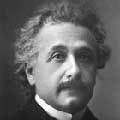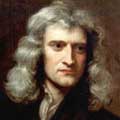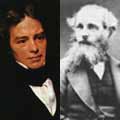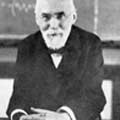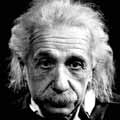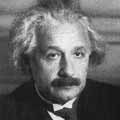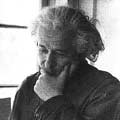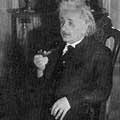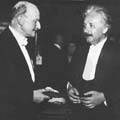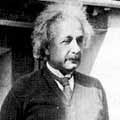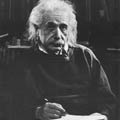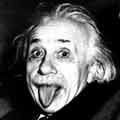Physics: Isaac Newton's Mechanics
Albert Einstein explains Newton's Space, Time & Matter
'Particles'.
Simple solution with the Wave Structure of Matter in Space.
It seems probable to me that God in the beginning
formed matter in solid, massy, hard, impenetrable, movable particles, of
such sizes and figures, and with such other properties, and in such proportion
to space, as most conduced to the end for which he formed them; and that
these primitive particles being solids, are incomparably harder than any
porous bodies compounded of them; even so very hard, as never to wear or
break in pieces; no ordinary power being able to divide what God himself
made one in the first creation.
(Sir Isaac Newton, From 'The Tao of Physics', p64)
The Particle/Space Duality of Newton's Mechanics
We begin with a very good summary of Atomism, as their ultimate conclusion, that the 'particle' is a conceptual tool for the logical positivist / mathematical physicist, but does not physically exist, is absolutely correct. (As the Principles state, the 'particle' effect is Caused by the Wave-Center of the Spherical Standing Wave.)
Atomism arose as an explanatory scheme with the ancient
Greeks (around 400BC), Leucippus and Democritus, and Epicurus, and the
Roman poet, Lucretius. At the most fundamental level atomism is the belief
that all phenomena are explicable in terms of the properties and behaviour
of ultimate, elementary, localized entities (or 'fundamental particles').
Thus it prescribes a strategy for the construction of scientific theories
in which the behaviour of complex bodies is to be explained in terms of
their component parts. That strategy has led to many of the successes of
modern physical science, though these do not prove that there actually
are 'ultimate entities' of the type postulated by atomism.
Their (the atomists) analysis goes 'behind' the appearance of minute, unchangeable
and indestructible 'atoms' separated by the emptiness of 'the void'. It
is the void which is said to make change and movement possible. All apparent
change is simply the result of rearrangements of the atoms as a consequence
of collisions between them. This seems to lead to mechanical determinism,
though, in an attempt to leave room for freewill, Epicurus and Lucretius
postulated that atoms might 'deviate' in their courses.
However if 'what exists' is 'atoms', what of the 'void'? In different ways
both Aristotle and Descartes denied that there could be such a thing as
literally 'empty space'. Physically therefore they saw the world as a plenum.
Atomism was also associated with atheism, since as Lucretius put it, 'Nothing
can ever be created out of nothing, even by divine power.' Conversely no
thing can ever become nothing - so the atomists proposed a strict principle
of conservation of matter.
The attempt of the ancient atomists to solve a metaphysical problem about
the nature of change resulted in a brilliantly fruitful strategy for the
construction of theories in the physical sciences. However there are unanswered
philosophical objections to atomism and the very successes it has stimulated
suggest that 'the stuff of the world' cannot ultimately be understood in
terms of atomism. A thoroughgoing positivism will continue to hold that
'atomic theories' are simply devices for talking about observable phenomena.
(The Concise Encyclopedia of Western Philosophy and Philosophers, 1991)
With this understanding of the 'particle' in mind, and with Albert Einstein as our guide, we shall now explain and solve Newton's Mechanics, and thus also appreciate how this theory profoundly (though incorrectly) shaped the face of modern physics.
Isaac Newton on Time, Particles & Forces
(Instant Action-at-a-Distance)
We begin with two very famous quotes from Newton on Absolute Space and Time. Let us first say that Newton's comments on Absolute Space being the foundations of the Relative Motions of Matter in Space is absolutely correct and very astute as Newton effectively predicts the evolution of relativity (that it is easier to measure the motion of matter relative to other matter, rather than to Space itself!)
Absolute Space, in its own nature, without regard to any thing external, remains always similar and immovable. Relative Space is some moveable dimension or measure of the absolute spaces; which our senses determine, by its position to bodies; and which is vulgarly taken for immovable space.
... And so instead of absolute places and motions, we use relative ones; and that without any inconvenience in common affairs; but in Philosophical disquisitions, we ought to abstract from our senses, and consider things themselves, distinct from what are only sensible measures of them. For it may be that there is no body really at rest, to which the places and motions of others may be referred.
... Absolute, True, and Mathematical Time, of itself, and from its own nature flows equably without regard to any thing external, and by another name is called Duration: Relative, Apparent, and Common Time is some sensible and external (whether accurate or unequable) measure of Duration by the means of motion, which is commonly used instead of True time; such as an Hour, a Day, a Month, a Year.
... For the natural days are truly unequable, though they are commonly consider'd as equal, and used for a measure of time: Astronomers correct this inequality for their more accurate deducing of the celestial motions. It may be, that there is no such thing as an equable motion, whereby time may be accurately measured. All motions may be accelerated and retarded, but the True, or equable progress, of Absolute time is liable to no change. The duration or perseverance of the existence of things remains the same, whether the motions are swift or slow, or none at all. (Newton, 1687)
Newton is also largely correct that Time is intimately connected to Motion, for Time is ultimately caused by the Wave-Motions of Space. It is also correct to assume an absolute Time (like QT rather than Relativity) such that we have a constant reference to measure the changing velocity of wave-motion. (But Time does not exist as a 'thing in itself' like Newton thought!)
Let us now consider Albert Einstein's analysis of Newton's Mechanics (which is lucid and logical as reflects the greatness of Albert Einstein).
The first attempt to lay a uniform theoretical foundation
was the work of Newton. In his system everything is reduced to the following
concepts:
i) Mass points with invariable mass
ii) Instant action-at-a-distance between any pair of mass points
iii) Law of motion for the mass point.
Physical events, in Newton's view, are to be regarded as the motions, governed
by fixed laws, of material points in space. This theoretical scheme is
in essence an atomistic and mechanistic one. There was not, strictly speaking,
any all-embracing foundation, because an explicit law was only formulated
for the actions-at-a-distance of gravitation; while for other actions-at-a-distance
nothing was established a priori except the law of equality of
actio and reactio. Moreover, Newton himself fully realized that time and
space were essential elements, as physically effective factors, of his
system. (Albert Einstein, 1940)
We now realise his obvious error was to introduce discrete 'particles' with Motion, rather than the Motion of Space itself, i.e. Spherical Standing Wave Motion, which creates the 'particle effect' at its Wave-Center.
Newton's endeavours to represent his system as necessarily conditioned by experience and to introduce the smallest possible number of concepts not directly referable to empirical objects is everywhere evident; in spite of this he set up the concept of absolute space and absolute time. For this he has often been criticized in recent years. Therefore, in addition to masses and temporally variable distances, there must be something else that determines motion. That something he takes to be relation to absolute space. He is aware that space must possess a kind of physical reality if his laws of motion are to have any meaning, a reality of the same sort as material points and their distances. (Albert Einstein, 1954)
As stated in the first chapter, Albert Einstein considered matter to be spatially extended (and represented by Spherical Force Fields) thus he did not believe in the existence of a fundamental Space or Time that was separate from Matter. As with Leibniz and Mach, Albert Einstein believed that all motion of matter in Space could instead be understood as motion of matter relative to other matter, thus the concept of an absolute Space became unnecessary.
In Newtonian physics the elementary theoretical concept on which the theoretical description of material bodies is based is the material point, or particle. Thus matter is considered a priori to be discontinuous. This makes it necessary to consider the action of material points on one another as action-at-a-distance. Since the latter concept seems quite contrary to everyday experience, it is only natural that the contemporaries of Newton - and indeed Newton himself - found it difficult to accept. Owing to the almost miraculous success of the Newtonian system, however, the succeeding generations of physicists became used to the idea of action-at-a-distance. Any doubt was buried for a long time to come. (Albert Einstein, 1950)
The solution though is obvious once known - to discard the discrete particle in Space and replace it with the Spherical Standing Wave (SSW) in Space. Then instant action-at-a-distance between discrete particles becomes action-at-a-distance between the In and Out-Waves of the Wave-Centers 'particles' in Space.
This leads to a clear understanding of how matter interacts with other matter at-a-distance in Space, as it is the interaction of the In-Waves and Out-Waves with other SSWs (and particularly their Wave-Centers) that explains all matter to matter interactions in Space. These interactions are limited by the velocity of the In-Waves and Out-Waves which is the velocity of light c. Thus actions-at-a-distance are not instantaneous as Newton had assumed, but are limited by the velocity of the In-Waves (velocity of light c, as Albert Einstein realised).
On the other hand, with respect to an absolute Space, it is one purpose
of this article to show that in fact Newton was correct, there does exist
a fundamental physical Space which acts as a wave medium and necessarily
connects all things. Newton's error was to further assume the existence
of the motion of material particles in this Space, rather than the (Spherical)
Wave-Motion of Space itself.
Newton's error, of assuming too many existents, leads to two insurmountable
problems;
a) How does matter exist as a discrete particle in Space and move through the Space around it?
As Born explains;
One obvious objection to the hypothesis of an elastic Aether (Space) arises from the necessity of ascribing to it the great rigidity it must have to account for the high velocity of Waves. Such a substance would necessarily offer resistance to the motion of heavenly bodies, particularly to that of planets. Astronomy has never detected departures from Newton's Laws of Motion that would point to such a resistance. (Born, 1924)
While Born is correct that Space is very rigid and this explains the high Wave-Velocity, he (along with most physicists) mistakenly assumes that separate 'particles' exist in this Space, and thus it is inconceivable that Space itself can exist as it would resist the motion of these particles. The obvious solution is to replace the concept of matter existing as discrete particles with matter existing as Spherical Standing Waves in this Space, thus the motion of the particle becomes the apparent motion of successive Wave-Centers.
b) How do these discrete particles gravitationally act-at-a-distance with other particles separate in Space?
Newton simply assumed that discrete particles could act instantly on other particles at-a-distance in Space (Newton's instantaneous action-at-a-distance) though he was well aware of this problem as he explains in his famous letter to Bentley;
It is inconceivable that inanimate brute matter should,
without mediation of something else which is not matter, operate on and
affect other matter without mutual contact. ... That gravity should be
innate, inherent and essential to matter, so that one body may act upon
another at-a-distance, through a vacuum, without the mediation of anything
else by and through which their action may be conveyed from one to another,
is to me so great an absurdity that I believe no man, who has in philosophical
matters a competent faculty of thinking, can ever fall into it.
So far I have explained the phenomena by the force of gravity, but I have
not yet ascertained the cause of gravity itself. ... and I do not arbitrarily
invent hypotheses. (Newton. Letter to Richard Bentley
25 Feb. 1693)
Action-at-a-distance has puzzled philosophers and physicists since Newton first assumed instantaneous action-at-a-distance for gravitational Mass. For if matter is assumed to be a tiny particle, how could it interact (instantly!) with other matter at a distance in Space (across the entire universe)?
For example, how do we, here on earth, sense the heat and light from the sun so distant in Space. We now realize that matter is not small, it is large. Indeed Albert Einstein was very close to the truth - matter is spherically spatially extended, thus as we have said, Newton's instant action-at-a-distance from a particle becomes action-at-a-distance from the Wave-Center of Spherical Standing Waves in Space, due to the interaction and change in velocity of their In and Out-Waves.
i.e. As a consequence of Principle Two, the In-Waves of the Spherical
Standing Wave in Space interact with other SSWs in Space (particularly
their high Wave-Amplitude / Energy Density Wave-Centers) as they flow in
through them and change their velocity accordingly.
This determines where each successive In-Wave will ultimately meet at their
respective Wave-Center (i.e. the future position of the Wave-Center / 'particle')
which causes the apparent motion (acceleration) of the 'particle'. This
then explains action-at-a-distance (from the Wave-Center) and why it is
not instantaneous, but rather, is limited by the velocity of the In-Waves
/ Velocity of light c.
Sir Isaac Newton's Concept of Light as a Particle
It is true that Newton tried to reduced light to the motion of material points in his corpuscular theory of light. Later on, however, as the phenomena of finite velocity, polarization, diffraction, and interference of light forced upon this theory more and more unnatural modifications, Huygens' undulatory wave theory of light prevailed. (Albert Einstein, 1936)
Albert Einstein clearly realized, as did physicists of the time, that the particle concept of light is unable to explain experimental phenomena like polarization, diffraction, and interference, which are obviously explained by wave phenomena. This divide between Newton's particle conception of light and Huygens' wave theory of light was decided by Thomas Young's (1801) famous double slit experiment which showed interference patterns that could only be explained by a wave theory. For how could a single particle travel through two slits and interfere with itself?
Further, as Albert Einstein argues, it is impossible to explain how particles of matter emit and absorb particles of light.
What in that case becomes of the material points of which light is composed when the light is absorbed? (Albert Einstein, 1931)
So while Newton's particle theory for light and matter had substantial logical (mathematical) success at explaining certain phenomena, particularly the orbits of planets, it clearly produced many paradoxes due to its fundamental error of assuming the existence of discrete particles.
Yet no serious doubt of the mechanical (particle) foundation of physics arose, in the first place because nobody knew where to find a foundation of another sort. Only slowly, under the irresistible pressure of facts, there developed a new foundation of physics, 'Field' physics. (Albert Einstein, 1954)
We shall shortly consider the 'Field' physics, but before this we need to finally explain Newton' famous Law of Inertia;
An object at rest will remain at rest and an object in motion will continue in motion with a constant velocity unless it experiences a net external force. (Serway, 1992)
Sir Isaac Newton's Law of Inertia F = m.a
Mass is caused by the Relationship between Change in Velocity c of the In-Wave and the resultant Change in Location of the Wave-Center / Acceleration of the 'Particle'.
By understanding the properties of space and how they effect the velocity of waves we can now simply explain Newton's Law of Inertia F=m.a which is at the very heart of Physics.
This explains how matter 'particles' (Wave-Centers) are 'Necessarily Connected' to other Matter in the Space around them, and thus leads to the explanation of 'Force' and Newton's famous Law of Inertia Force = Mass * Acceleration (F=m.a)
Consider the Spherical In-Waves of One Electron / Spherical Standing Wave (SSW).
If there is no change in the velocity of the Spherical In-Wave then there
can be no change in the apparent motion of the Wave-Center / 'particle'.
i.e. If the Spherical In-Waves comes in with the same velocity in all directions
then the Wave-Center / 'particle' will remain stationary in the same place
in Space.
Conversely, if there is a change in velocity of the Spherical In-Waves in one direction then this will also cause a change in the location where the wave center 'particle' forms in Space which we see as the motion (acceleration) of the Wave-Center / 'particle'.
So when we consider the future motion of a particle we must actually consider the velocity of the Spherical In-Waves only, for it is logical that this alone determines where these In-Waves will meet at their future Wave-Centers.
This is the underlying cause of the Law of Inertia and the concepts of force, mass and acceleration. We can now translate the language of physics into the language of the WSM. When we apply a Force to an object we are in fact changing the velocity of their In-Waves, and this causes the wave center to re-position. It is this relationship between the change in velocity of In-Waves and the change in location (apparent motion / acceleration) of the Wave-Center that causes the concept of Mass and explains the necessary connection between apparently discrete matter particles. (i.e. Action-at-a-distance).
Though this is perhaps a little confusing upon first reading, with time it becomes more obvious that the Spherical Wave Structure of Matter simplifies and solves the problems of Newton's Mechanics by removing the concept of discrete 'particles' and replacing this with Spherical Wave Motions of Space whose Wave-Center's Cause the 'Particle' Effect.
Physics: Isaac Newton's Mechanics
Albert Einstein explains Newton's Space, Time & Matter
'Particles'.
Simple solution with the Wave Structure of Matter in Space.
Help Humanity
"You must be the change you wish to see in the world."
(Mohandas Gandhi)
 "When forced to summarize the general theory of relativity in one sentence:
Time and space and gravitation have no separate existence from matter. ... Physical objects are not in space, but these objects are spatially extended. In this way the concept 'empty space' loses its meaning. ... The particle can only appear as a limited region in space in which
the field strength or the energy density are particularly high. ...
"When forced to summarize the general theory of relativity in one sentence:
Time and space and gravitation have no separate existence from matter. ... Physical objects are not in space, but these objects are spatially extended. In this way the concept 'empty space' loses its meaning. ... The particle can only appear as a limited region in space in which
the field strength or the energy density are particularly high. ...
The free, unhampered exchange of ideas and scientific conclusions is necessary for the sound development of science, as it is in all spheres
of cultural life. ... We must not conceal from ourselves that no improvement in the present depressing situation is possible without
a severe struggle; for the handful of those who are really determined to do something is minute in comparison with the mass of the lukewarm
and the misguided. ...
Humanity is going to need a substantially new way of thinking if it is to survive!" (Albert Einstein)
 Our world is in great trouble due to human behaviour founded on myths and customs that are causing the destruction of Nature and climate change. We can now deduce the most simple science theory of reality - the wave structure of matter in space. By understanding how we and everything around us are interconnected
in Space we can then deduce solutions to the fundamental problems of human knowledge in physics, philosophy, metaphysics, theology, education, health, evolution and ecology, politics and society.
Our world is in great trouble due to human behaviour founded on myths and customs that are causing the destruction of Nature and climate change. We can now deduce the most simple science theory of reality - the wave structure of matter in space. By understanding how we and everything around us are interconnected
in Space we can then deduce solutions to the fundamental problems of human knowledge in physics, philosophy, metaphysics, theology, education, health, evolution and ecology, politics and society.
This is the profound new way of thinking that Einstein
realised, that we exist as spatially extended structures of the universe - the discrete and separate body an illusion. This simply confirms the
intuitions of the ancient philosophers and mystics.
Given the current censorship in physics / philosophy of science journals (based on the standard model of particle physics / big bang cosmology) the internet is the best hope for getting new knowledge
known to the world. But that depends on you, the people who care about science and society, realise the importance of truth and reality.
It is Easy to Help!
Just click on the Social Network links below, or copy a nice image or quote you like and share it. We have a wonderful collection of knowledge from the greatest minds in human history, so people will appreciate your contributions. In doing this you will help a new generation of scientists see that there is a simple sensible explanation of physical reality - the source of truth and wisdom, the only cure for the madness of man! Thanks! Geoff Haselhurst (Updated September, 2018)
A new scientific truth does not triumph by convincing its opponents and making them see the light, but rather because its opponents eventually die, and a new generation grows up that is familiar with it. (Max Planck, 1920)
| Tweet Follow @philosophytruth | |
| Geoff | |
Connect with Geoff Haselhurst at Facebook
"All that is necessary for evil to succeed is for good people to do nothing."
(Edmund Burke)
"In a time of universal deceit - telling the truth is a revolutionary act."
(George Orwell)
"Hell is Truth Seen Too Late."
(Thomas Hobbes)
Legal Disclaimer and Privacy Policy
